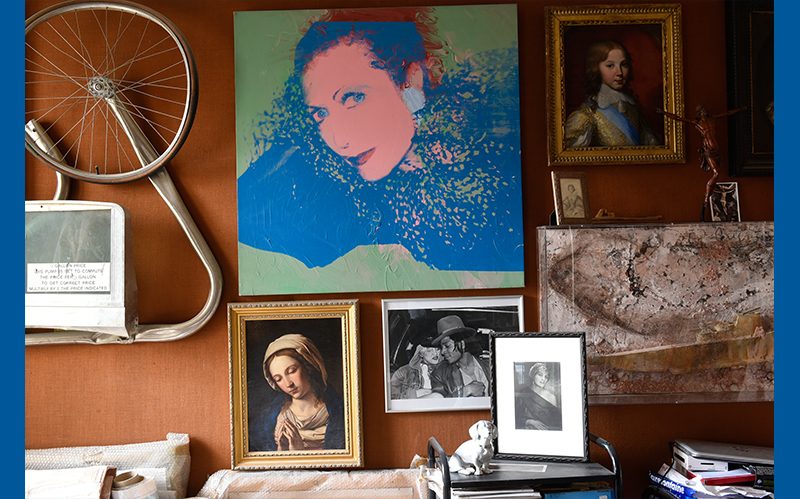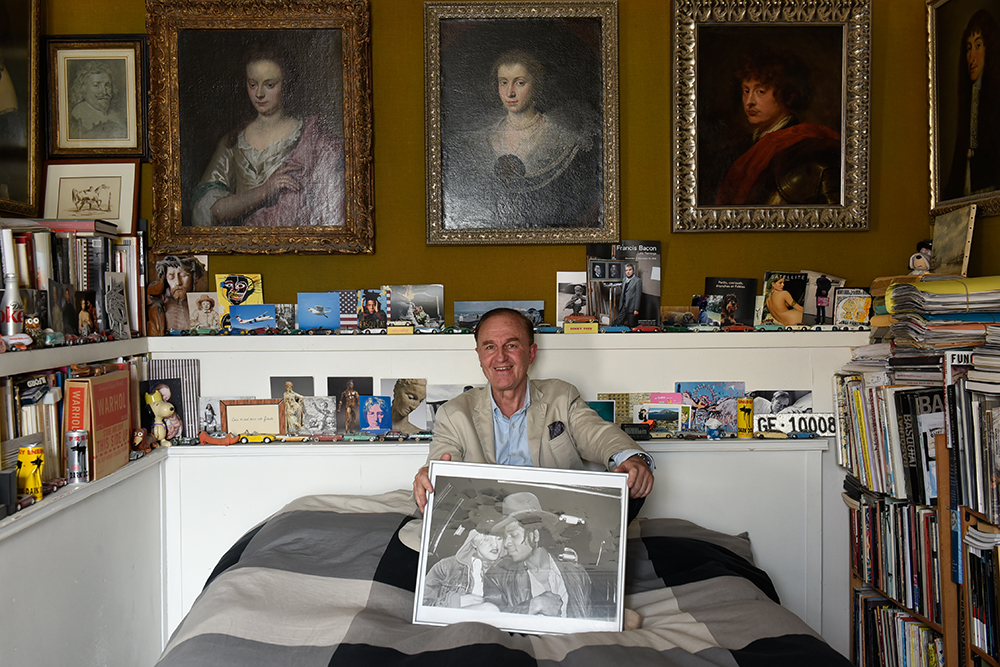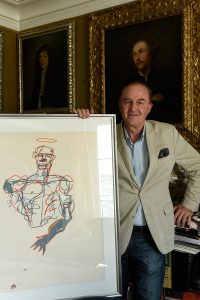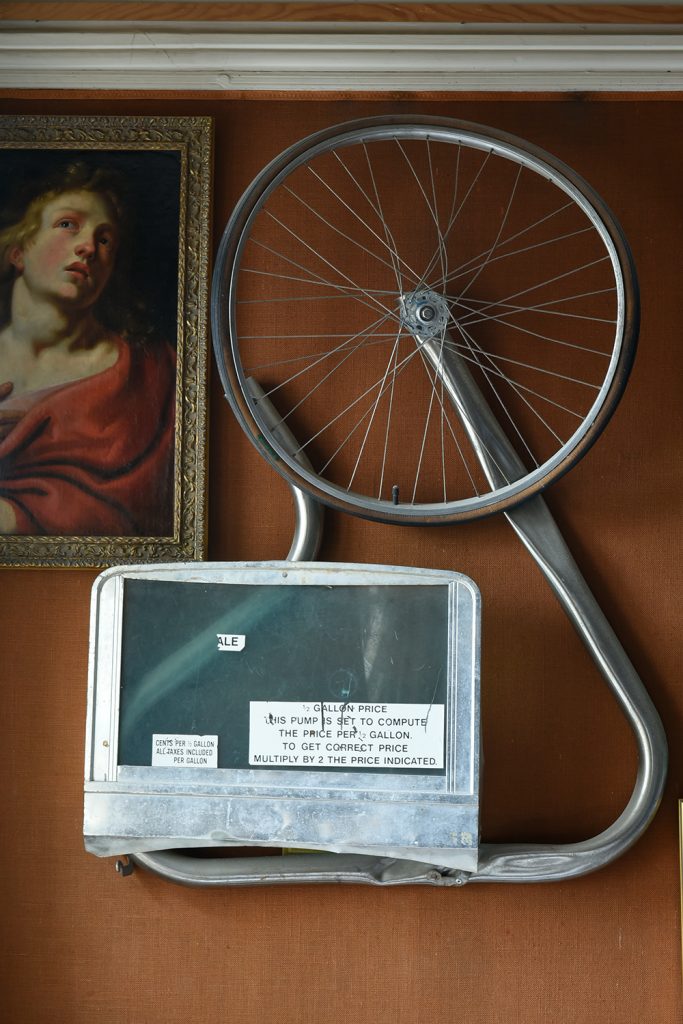
Richard Rodriguez was one of the first in France to recognise the importance of Jean-Michel Basquiat. After a Saturday visit to a flea market at Porte de Vanves in Paris, he welcomed us to his highly original house, where contemporary and old works of art interact in a fascinating way with impressive bric-a-brac.
A collector’s quest
As a youngster, Richard Rodriguez absorbed the art of the Renaissance on trips to Italy with his parents. Inspired by the protagonist of Michelangelo Antonioni’s film ‘Blow Up’, he dreamed of pursuing a career as a photographer, but his family disapproved. Rodriguez thus earned a doctorate in European law and became a lawyer.

From the Renaissance to contemporary art
He remained under the influence of the Italian Renaissance and – mostly out of frustration – began collecting drawings from the 16th and 17th centuries, which were more affordable than contemporary art. A friend took him to see the ‘Cabinet des Dessins’ collection of drawings at the Louvre. There, he honed his eye and learned to dive deep into the details when assessing works of art.
Rodriguez’s curiosity finally led him to contemporary art. He attempted to spot tomorrow’s classics among today’s artists – such as H.R. Giger, whose first Paris exhibition in the mid-1970s he had attended with great fascination. To Rodriguez, the great exhibitions of Cézanne in 1978 and Pollock in 1982 in Paris were the key to understanding modern art. He expanded his collection by works from the artist generation of the early 1980s – Pincemin, Blais, Combas, Beuys, Rauschenberg and Warhol. Encounters with Beuys and Buren turned out to be decisive.
In 1984, Richard Rodriguez met the graffiti artists of the Les Frères Ripoulin collective, who told him about a young American named Keith Haring. One evening, Rodriguez stumbled upon a captivating picture by Haring on the walls of Dupleix station in the Paris Métro next to works by the Frères Ripoulin. He removed the work from the wall and sold it a few years later to a prominent French collector. Rodriguez met Haring a few months before the artist died. ‘This is the guy who peeled me off ‘, Haring told his friends, and thanked Rodriguez for preserving the work, which he wished to buy back.
Richard Rodriguez: the man who brought France Basquiat

Rodriguez was one of the first French collectors to recognize the importance of Jean-Michel Basquiat. In 1987, when the dollar was weak, he took out a large loan that caused his friends to call him crazy and bought ‘Grigri’, a picture by Basquiat that he had fallen head over heels in love with; on a visit to Paris, the artist explained to him that it was one of his own favourite pictures. In 1988, before Basquiat died, one of his works went on sale that was reminiscent of a study of the ‘Condotierre’ inspired by Florentine culture. Given the lack of interest from most gallery owners, Rodriguez bought the work at auction, and it has adorned his business cards ever since. In spite of numerous offers, he never parted with the picture.
After Basquiat’s death, Rodriguez became convinced that the value of his works would increase rapidly. He sold almost his entire collection, giving him the means to create the first Basquiat collection. He organised the first Paris exhibition at the Musèe de la Seita, which had presented Egon Schiele the previous year, in 1992. In Rodriguez’s view, Schiele and Basquiat were both geniuses and suffered a similar fate. They not only died at the same age, but also both had famous mentors: Schiele had Klimt, and Basquiat had Warhol. When Rodriguez discovered an international network of Basquiat forgers, he finally achieved world renown as an expert on the painter.
Back to the old masters
Modern works fetched ludicrous prices at the 2012 FIAC Paris art fair – an irritating experience for Rodriguez. When, at an antiques dealership, he fell in love with a wonderful 18th-century portrait of an ‘Homme de qualité’ by Joseph-Siffrein Duplessis, he bought the painting and from then on followed his passion for old portraits that he traces back to a childhood memory. In his grandmother’s dining room, there was a copy of the ‘Baldassare Castiglione’ by Raffael. He was terrified of the painting, because his grandmother had warned him: ‘Be good, Richard, for this gentleman can see everything that you do.’
A fresh direction
Rodriguez now took a new path. He developed an interest in traditional painting and visited countless museums, trade fairs and auction houses, including, frequently, Dorotheum. After missing out on a portrait of Philip IV from Velásquez’s workshop at his first auction, he but got over his disappointment in October 2015, when he bought a portrait of George Petel ascribed to van Dyck’s Workshop. That painting was believed to be a copy of the version in the Alte Pinakothek in Munich. The ever-skeptical Rodriguez pointed to the long friendship between Petel and van Dyck, noting that the portrait depicts the young Petel with two irritating sties on his eyelid that were likely the result of contact with marble dust. Only the master himself, van Dyck, could have created such a precise detail. The art expert Wilhelm Suida wrote a letter backing this hypothesis in 1938. ‘The van Dycks are mine’, Richard Rodriguez laughed. The year before, he had bought a portrait of the Countess of Somerset that was also ascribed to the master’s workshop. In addition, the art expert Susan Barnes confirmed the painting’s creation under van Dyck’s aegis.
Two royal portraits adorn the walls of Rodriguez’s offices: one of Louis XIV as a child, and one of a woman. Rodriguez bought the latter at a flea market in Saint-Ouen and has identified the painting as a portrait of Anna of Austria, the aforementioned king’s mother. Both subjects bear the dimple that is owed to the brush of Beaubrun.
A glorious mix
Works and eras overlap in Richard Rodriguez’s house. There are several portraits of women, all of which are unusual. One shows a young girl with a shaved forehead from 1542, doubtless a Dutchwoman from Frisia. Another depicts a ‘Rembrandtesque woman in pearls and lace’ and is ascribed to Gerrit van Honthorst. The third, painted by Cornelis de Vos, is of a woman at home who appears to be caught by surprise, her lace collar open and her necklace out of place.

Although Richard Rodriguez surrounds himself mainly with old portraits, he has never sold any of the wonderful contemporary works that make his collection so unusual and of such high quality. He has kept Basquiat’s ‘Condottiere’ as well as two disturbing pictures by Anselm Kiefer (‘Ex voto’, which refers to the bombing of the World Trade Center, and an allegory of ‘Claudia Quinta’), a Roman Vestal Virgin, a Rauschenberg sculpture that presents an homage to his spiritual father, Marcel Duchamp, Warhol’s portrait of Hélène Rochas, and numerous photographs, including one of Basquiat with Madonna.
Dreaming big
At the end of our visit, the tireless storyteller and experienced art collector Richard Rodriguez told us that he dreams about two pictures that he will doubtless never own: Picasso’s ‘Les Demoiselles d’Avignon’ and Malevich’s ‘Carré blanc’.













